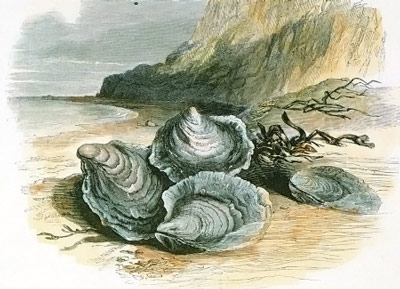Oyster & bacon pie.
A classic pairing beneath a flaky crust and one of the best of all recipes. It takes a while to prepare and is worth every ounce of effort, although a few shortcuts do not harm it much. As the notes to the recipe indicate, this pie reappears in slightly altered form, primarily through the addition of bell pepper and subtraction of mace, in twentieth century New Orleans. A nine-inch pie for six
For the pastry:
- 1 5/8 cups flour
- ½ teaspoon salt
 2/3 cup cold lard
2/3 cup cold lard- 2 to 3 Tablespoons icewater
For the filling:
- ½ lb chopped bacon
- ¼ cup flour
- 1½ generous cups chopped onion
- 1 cup chopped celery
- 1 teaspoon salt
- heaped ¼ teaspoon cayenne
- scant ¼ teaspoon mace
- ½ teaspoon pepper
- 2 bay leaves
- ¼ cup chopped flat leaf parsley
- ½ cup chopped scallions
- 2 cups whole milk
- 1 Tablespoon chopped garlic
- 3 dozen shucked, drained oysters
- Make the pastry. Mix together the flour and salt, then dump it into a food processor and give it a blast until it acquires the texture of coarse breadcrumbs. If you lack a processor, or simply dislike using them, work the lard into the seasoned flour with your fingers until it acquires the requisite texture.
- Add the water, a little at a time, until you have just enough moisture to form the dough into a smooth disc by gently pounding it with the palm of a hand. Use a little water as you can to avoid makings a soggy crust.
- Wrap the dough in plastic and refrigerate it for at least 45 minutes.
Preheat the oven to 400°.
- Fry the bacon in a heavy skillet on medium-low heat, then increase the heat to high after the bacon throws some fat to brown and crisp the bacon
- Remove the bacon with a slotted spoon and drain it on paper towels.
- Reduce the heat to medium, sprinkle the flour around the skillet and whisk it into the fat to make a roux .
- Quickly add the onion, celery, salt, cayenne, mace and black pepper. Stir-fry everything until the vegetables have softened.
- Add the bay, parsley, scallions, garlic and milk. Stir and cook the mixture until it thickens to a creamy texture.
- Turn off the heat, stir the bacon into the skillet, then gently fold in the oysters. Throw away the bay leaves.
- Cut a quarter out of the dough and reserve it for the top crust. Roll out the remaider on a floured surface and line a nine-inch pie pan with it.
- Dump the oyster filling into the pan, moisten the edges of the pastry, and roll out the reserved dough and lay it over the filling, pressing and crimping the edge of the pastry perpendicular to the rim of the pan with a fork.
- Slash some vents into the center of the top.
- Bake on a cookie sheet until the crust is golden, usually in about 45 minutes.
- Cool for ten minutes to thicken the filling and serve.
Notes:
- Other recipes specify fewer vegetables and (only 2 dozen) oysters but the Editor has found those amounts insufficient. Some recipes also instruct the reader to simmer the oysters until they curl before baking them. Down that path lies the madness of overcooked and therefore rubberized oysters.
- The Editor has frequently used a local applewood-smoked, maple cured bacon but anything will do.
- If you are unskilled in shucking oysters, shucked ones available in refrigerated flip-top buckets from the supermarket will do. Remember to drain them. Canned oysters, however, are horrible when used in this recipe. They emerge as fishy and shrunken little hardballs.
- The pastry is extremely “short” or fatty and dry, and therefore can be hard to work. It wants to crack and separate so use more water if needed… or buy frozen piecrust and thaw it. Some brands are not that bad. You also could use thawed storebought puff pastry but the shortcrust is best.
- The addition of a little Worcestershire to the filling at Step 8 does not hurt.
- A New Orleans oyster pie requires only a few alterations to the basic recipe. When you make the roux at Step 6, cook it longer, until it turns the color of peanut butter. You will need to whisk steadily to avoid scorching and ruining it. If you see black flecks in the roux, that has transpired; toss the roux and begin anew: There is no means to save it. At step 7, omit the mace; use only a cup of onion and ¾ cup of celery while adding about ¾ cup of chopped bell pepper to them; and cook the vegetables longer, until they turn golden. Finally toss a Tablespoon of minced garlic in with the other ingredients at Step 8. By all means add the otherwise optional Worcestershire there as well.

